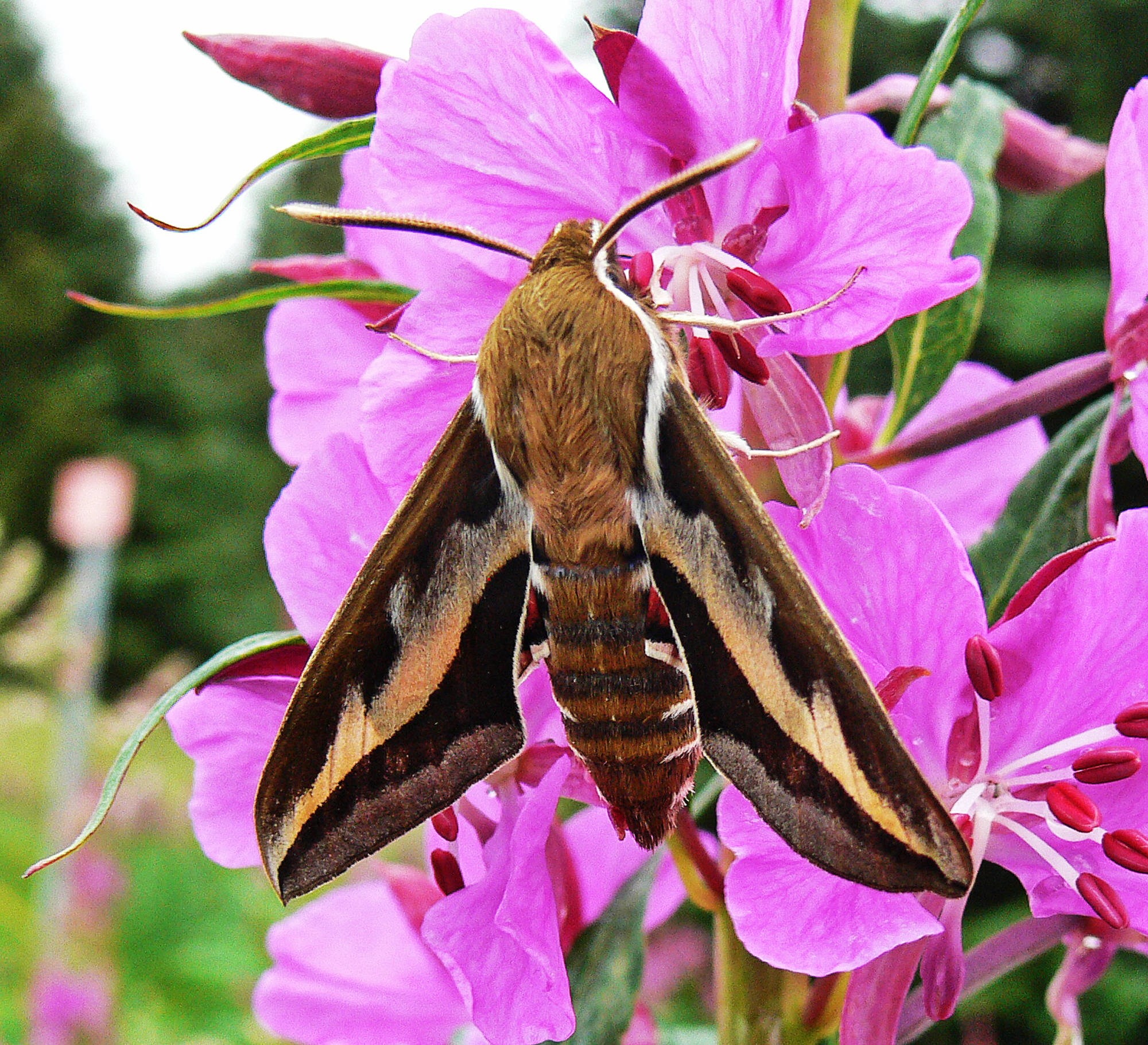If you walk through a field of fireweed, you might see spittle bugs, aphids and — if you are lucky — a hawk moth.
They hover at flowers on their rather narrow wings, extending their “tongues” to extract nectar. They can fly very fast, which may give them the common name of “hawk.” They’re also called sphinx moths: When a caterpillar is at rest, it raises the front part of its body and tucks the head down. Someone with a vivid imagination saw a resemblance to the famous Egyptian Sphinx.
There are well over 1,400 species of hawk moth in the world. Some specialize on extracting nectar from orchids while often pollinating them. Many hawk moths have long proboscides (“tongues”) suitable for extracting nectar from the long nectar spurs of certain flowers. When there is a good fit between the length of the spur and the length of the proboscis, the moth can pick up pollen on its eyes or face and transfer it to another orchid. If the proboscis is too short, the moth can’t reach the nectar in a long spur and is not likely to visit that kind of orchid very often. If the proboscis is too long, the moth’s head or body will not contact the place in the flower where the pollen is produced, so although the moth can steal some nectar, pollination is unlikely (unless it happens that the pollen is contacted by the proboscis itself).
The most famous of these relationships (as I mentioned in an earlier essay) concerns the Madagascar star orchid, whose prodigiously long (11 inches or so) nectar spur caused Darwin to predict the existence of a suitable moth with an equally long proboscis. Sure enough, someone else eventually found that predicted moth in action. Now there are rumors that a second species of long-tongued hawk moth can reach the nectar and do some pollination of this orchid.
A little closer to home in the swamps of Florida and Cuba, the ghost orchid lives high up on tree branches. The nectar spur is said to be about 5 inches long (but variable), and it is now known that several species of hawk moth can pollinate this species. Unfortunately, the orchid is now quite endangered, in part because of over-collecting by horticulturalists.
Slightly closer to Alaska, in the tall-grass prairies, the fringed prairie orchids are pollinated by hawk moths. The western fringed prairie orchid has a nectar spur over 2 inches long, which is said to be longer than most other North American orchids. It is known to be pollinated by four species of native hawk moths (perhaps more) and by one non-native species that was introduced to North America from Eurasia to help control an invasive weed. This species of orchid is designated as “threatened,” largely because of habitat loss as the prairies were plowed under for agriculture. But in addition, the moths are at risk from pesticides drifting over from the agricultural fields. Some published accounts say that no seed set is accomplished in the absence of moth pollination, but others say that a little self-pollination without the help of the moths is possible. In either case, reproduction is generally poor.
In Alaska, little is known about the relationships of hawk moths to flower pollination. Of the seven species on record in the state museum, only some are represented by more than a few specimens.
Here in Juneau, we sometimes see the bedstraw hawk moth (Hyles gallii) as the adults visit fireweed and other flowers. Two local orchid watchers have seen and photographed this moth visiting the white bog orchid, carrying pollen on its fairly long proboscis (about an inch long). Is this moth a regular pollinator of this orchid? Hawk moths elsewhere are known to pollinate related species of orchid, but it has been thought that this orchid is pollinated mostly by moths that sit on the flower while they sip nectar (instead of hovering, as a hawk moth does). In any case, hawk moths seem to be uncommon around here, so their role in pollination may be occasional at best.
Another hawk moth that we occasionally see here is called the hummingbird hawk moth (Hemaris thysbe). The wings are clear, without any colorful scales. This species is known to visit many kinds of flowers, including some orchids similar to the white bog orchid, but how many of these visits accomplish pollination is not known. The proboscis is of medium length (less than an inch), so deep nectar sources are not available to this moth.
One other fairly well-represented species in the museum collection is the one-eyed sphinx moth (Smerinthus cerisyi), which sports pretty blue eyespots on the hind wings. Although I don’t know if it has been recorded in Juneau, there are records from coastal British Columbia and from near the head of Lynn Canal, so it seems possible that we might see it here. It has an extremely short proboscis (only a few millimeters long), and one source states that it is not functional at all. In that case, the adults would not feed and there would no pollination.
Hawkmoth caterpillars are often called horn worms for the horn-like projection that sticks up from the rear end. The three Alaska species I’ve mentioned all have “horns,” although not all hawk moth caterpillars do. The caterpillars are herbivorous, commonly eating a variety of leaves. Bedstraw caterpillars eat fireweed, plantain, enchanter’s nightshade and many other things, in addition to bedstraw. Hummingbird caterpillars eat snowberry, blueberry, cherry, thistle, clover and more. One-eyed sphinx caterpillars forage chiefly on willow and poplar, but occasionally other species, too.
• Mary F. Willson is a retired professor of ecology. “On The Trails” is a weekly column that appears every Wednesday. Entomologist Derek Sikes assisted with providing information for this column.

